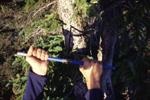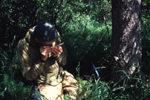|
|
|
|
|
|
1) What are tree rings?Wood is made of cells called xylem that mainly carry water from the tree's roots up to its leaves. Xylem cells are actually dead when they carry the water-- just hollow tubes. Every year, the tree produces new xylem cells from an area under its bark (a ring of tissue called the "vascular cambium"). The cambium makes xylem cells all summer long. Early in the summer, when it is warm and the water is plentiful, the xylem cells produced are big. These early cells are called "early wood," and look light-colored in the wood. As the summer goes on, temperatures cool and water becomes scarce (in some places), the xylem cells produced are small. These late cells are called "late wood," and look dark-colored in the wood. Together, the band of light- and dark-colored wood makes up one "annual ring," or one year's growth. Check out any cut spruce tree stump and you can see the annual rings. (PICTURES: xylem cells, early vs late wood, concentric rings, pics of cores...) 2) What did we do?Cored trees: screw in borer, pull out core, sand it down, measure/count. 3) What can we learn?The study of tree rings is called "dendrochronology." Basic things: age (estimate b/c not at base and rings are sometimes absent) growth rate. Lots of things influence a tree's growth rate: temperature, moisture, porcupines! By looking at growth changes over time, we can learn things about how the tree's environment has changed over time. (caution:) microsite variation like trees dying (new resources) or trees shading out other trees. (PICTURES: tree core up close with ages marked in years, different growth rates/rings)
Click here to download a free RealPlayer so you can listen. |
|
|
|
|
|
Click here to learn more about "dendrochronology"-- the study of tree rings. How to use tree cores from different parts of the tree-- looking at growth form. |
|
|
|
|
All Rights Reserved (R) Middlebury College Biology, 1999, 2000





